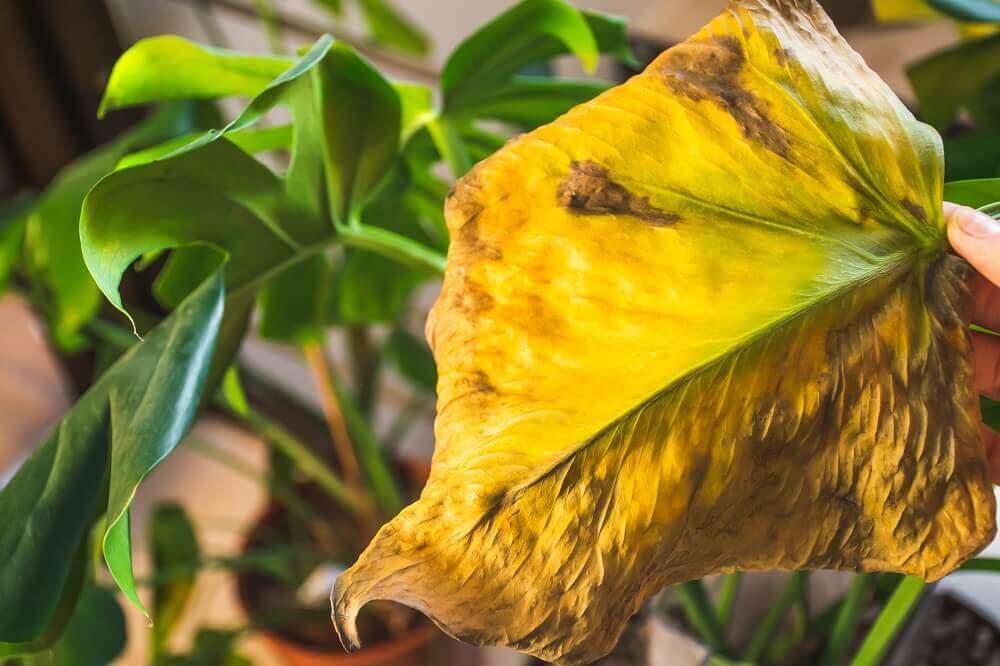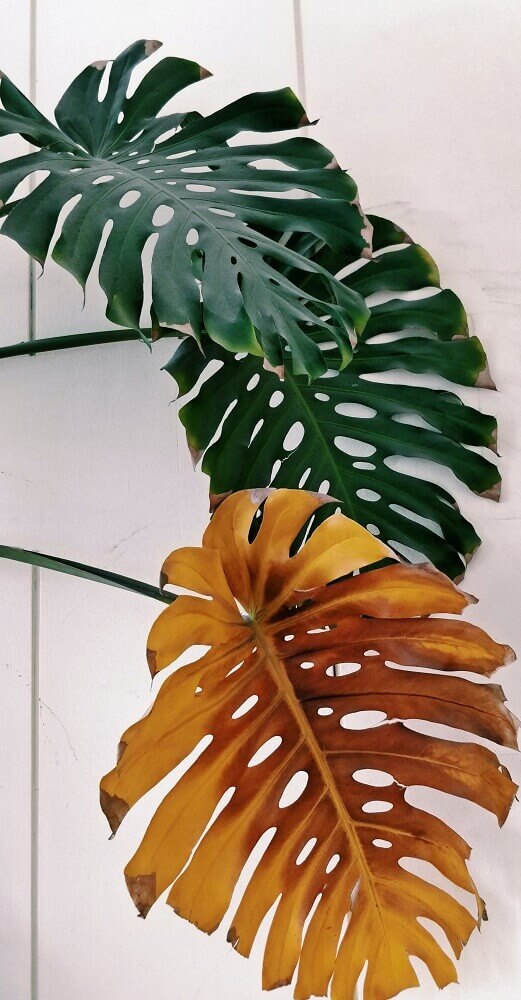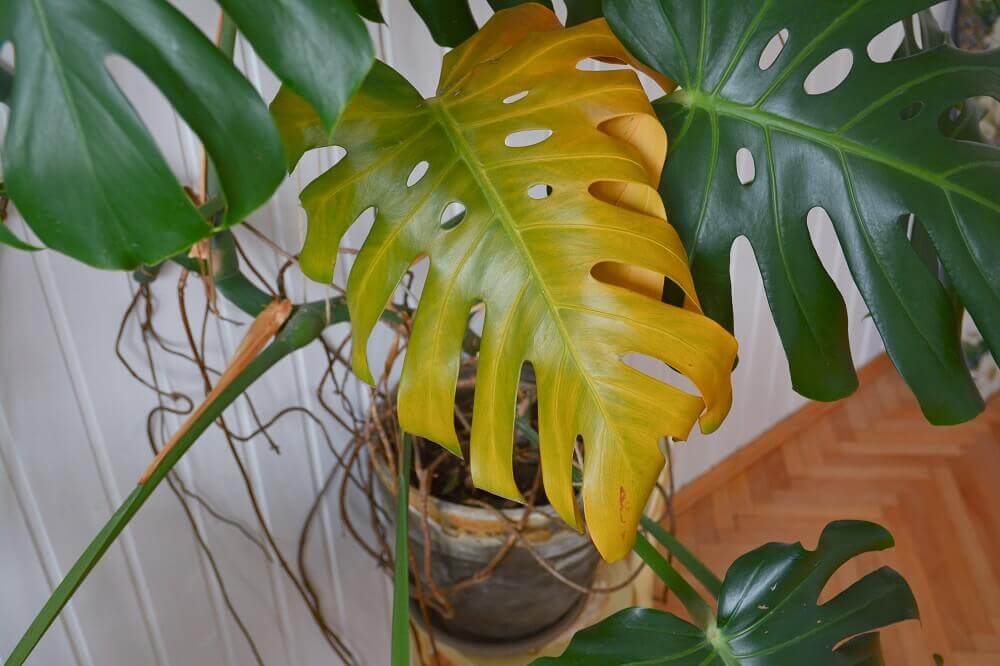
Monstera Deliciosa or the Swiss Cheese is a widely known indoor plant. The houseplant has gained immense popularity across the world due to its intricately shaped leaves. One can easily identify the plant by its distinctive pattern on the leaves. In fact, monstera’s luscious green and vibrant leaves can beautify any home decor.
Like any other houseplant, Monstera deliciosa is also susceptible to some external factors. Even though a plant enthusiast can easily grow a Monstera Deliciosa, a small mistake can turn out to be a potential danger for the plant. Yellowing of the leaves is such a kind of issue you can encounter at any time.
If you have not grown a Monstera before, the yellow leave issue can frustrate you a lot. Multiple factors like inappropriate watering, inadequate light, temperature stress, improper fertilization, etc. can invite yellow leaves problem. However, before you think about a solution, you must confirm the root cause first.
The article will help you understand the most possible causes of yellow leaves of monstera and discuss their solutions. Hence, identify the actual culprit and give your lovable friend a new lease of life. If you are a new plant parent, this tutorial is going to help you a lot.
TL; DR:
Repotting, inappropriate watering, temperature stress, nutrient deficiency, insufficient light, outgrew roots, life cycles, etc. are some of the most potent causes of yellowing leaves in the Monstera plant. Yellowing of leaves is a common problem in Monstera plant and a plant parent can easily fix it with a little care, support and precautions.
Table of Contents
Why Are Your Monstera’s Leaves Turning Yellow? Causes

Yellowing of leaves is a symptom of several health problems and the sign can irritate you a lot. Monstera Deliciosa is known for its flourishing green leaves that can improve your mood anytime. As a plant parent, you will never expect your Monstera to have yellow leaves. However, the good thing is that you can still save your plant from getting worse.
Yellow leaves are an early sign of serious health issues and if you do not take action to save your Monstera plant now, your plant may face irreversible damage. Here, we have included some of the most possible causes of yellowing leaves in Monstera. If you are wondering why your Monstera’s leave are turning yellow, the information provided above can clear all your doubts.
-
Repotting:
Repotting is a common cause of yellowing leaves in Monstera Deliciosa plants and this is something you need to watch out for. Although drooping is the most common issue plant parents face after repotting their Monstera, improper watering, irregular drainage, and poor soil can also invite the yellow leaves problem in your Monstera plant.
We often get back to our normal watering routine soon after repotting the plant. Before you do so, make sure the soil is well-drained. Poor drainage can increase overwatering issues. Conversely, if the drainage set up in the new pot is better than the old pot; your Monstera can suffer from underwatering. Hence, repotting can be a potential cause for yellowing leaves in Monstera.
Solution:
You can save your Monstera from repotting stress by giving it proper care and support. You can put the plant back in the same place and under the same condition, it has been enjoyed earlier. Do not change your watering schedule and avoid putting the plant under heavy or too dim light.
If you see that the roots have outgrown, you can trim them out before placing the plant in a new pot. It is better to not fertilize the plant until it recovers from repotting stress.
-
Inappropriate Watering:
The leaves of your Monstera can turn yellow due to inappropriate watering practices. Both over and under watering can be responsible for yellowing leaves in your plant. If your Monstera does not get sufficient water, its leaves will turn dry and brittle and die subsequently.
You can use your finger to check the moisture level in the soil or use a moisture meter to identify the issue and give the plant a drink if required. Remember, if your Monstera is suffering from an underwatering problem, you will encounter yellowing leaves all over the plant.
If you overwater your Monstera, it will droop and have brown spots on the leaves. Overwatering can be responsible for yellowing leaves. Frequent watering can make the soil wet and soggy, which is not good for the health of the roots. If you continue to give your Monstera too much water, you will find leaves at the lower level have started getting yellow.
Sometimes, soil loses its water retention capacity and you have to be careful about this. In such a condition, you will see your plant drinking more water than usual.
Solution:
Before you adjust your watering schedule, you have to identify the symptoms. The best way to identify the watering issue is to insert your finger a couple of inches into the soil to check humidity and dryness.
If the soil is wet and soggy, be gentle with your watering practices. Likewise, it is quite easy to fix the underwatering issue. Perform the finger test and if you find it dry and dusty, your Monstera needs a drink. You just have to be more regular with your water schedule.
-
Temperature Stress:
Hot and moist rainforests are the usual environment for tropical plant Monstera. Winter is not a suitable condition for Monstera Deliciosa plants and they do not like it. Sometimes, houseplants like Monstera stop growing in winter. If the temperature of the environment is below 50°F (10°C), the leaves of a Monstera plant can become yellow.
Monstera plants cannot tolerate extreme low or high temperatures. For example, if you put the plant under extreme sunlight, you will start encountering many issues like drooping, yellowing leaves, brown spots, etc.
Remember, whether it is from extreme hot or extreme cold, any kind of temperature stress is bad for your Monstera. Younger leaves are more vulnerable to such conditions than older leaves and that is why you might see younger leaves getting more affected by temperature stress than the older leaves.
Seasonal changes can also cause temperature stress and affect the health and appearance of your Monstera plant. Cooler weather and sudden temperature changes can also turn leaves dry and yellow.
Solution:
If the leaves of your Monstera Deliciosa plant are turning yellow due to temperature stress, just check its location and surroundings. Keep the plant away from the scorching afternoon sun in the summer and cold waves in the winter. Make sure you have not put the plant near or under the hot radiator or air conditioning system. Keep the plant in a place, where the temperature is stable and moderate.
-
Nutrient Deficiency:
Nutrient deficiency is another possible reason behind yellowing leaves in Monstera Deliciosa plants. If you see the leaves of your Monstera turning yellow despite the plant having a favorable growing condition, you can hold nutrient deficiency responsible for this.
If you have not fertilized the plant for more than a couple of months, your Monstera is likely to suffer from nutrient deficiency. A growing Monstera plant requires frequent fertilization. It can absorb all available nutrients within a couple of months.
Even though Monstera Deliciosa does not require too many supplements to grow indoors, occasional fertilization can encourage the plant to grow green and shiny leaves. A nitrogen-rich mix can help an indoor plant like Monstera Deliciosa to stay healthier and grow beautiful leaves.
On the contrary, over-fertilization can invite many troubles for your Monstera plant. If you overfeed the plant, it will react with symptoms like drooping, yellow leaves, brown spots, etc. Also, burn from over-fertilization often runs through the entire plant. Both nutrient deficiency and over-fertilization can invite issues like yellowing leaves in Monstera. Hence, you have to be careful when feeding your Monstera with nutrients.
Solution:
If your Monstera is suffering from nutrient deficiency, you have to feed your plant to help it thrive. Three major macronutrients for houseplants like Monstera Deliciosa are Nitrogen, Potassium, and Phosphorous. The best way to address nutrients deficiency is to add a well-balanced natural fertilizer to the soil.
On the other hand, if the leaves are turning yellow due to over-fertilization, flush the extra fertilizer with good watering and add fresh soil if required.
-
Insufficient Light:
If you are still wondering why your Monstera’s leaves turning yellow, you must inspect the light condition. Check whether the plant is getting sufficient indirect light. Even though direct sunlight especially in the summer is not recommended, you should ensure bright indirect light for your Monstera.
Also, insufficient light or poor lighting conditions can make the overwatering issue worse for the plant. Remember, a Monstera plant cannot grow freely under poor lighting conditions. Light deficiency can impact its growth and invite many other health issues like leggy or spindly stems, damp and moist soil, smaller leaves with fewer splits and holes, faded and yellowing leaves, etc.
Solution:
Insufficient light can affect physiological processes like photosynthesis, while extreme light can burn the leaves and stem. Hence, you have to make sure your Monstera is receiving moderate light.
Allow the plant to receive morning sunlight in the summer. If you cannot provide it with natural light, arrange artificial lighting systems designed for houseplants. Continuous exposure to extremely low light can also lead to root rot. If you find that the condition of the roots is not fine, consider repotting the plant with fresh soil.
-
Outgrown Roots:
Monstera Deliciosa plant can grow rapidly if allowed to thrive in an appropriate environment. Roots of a rapidly growing Monstera plant often struggle for space and eventually get into a condition called being root-bound.
In such a condition, it is quite common for a Monstera plant to show some symptoms like yellowing of leaves. Roots extract nutrients from available soil but outgrown roots lower the amount of soil in the pot. When a plant becomes root bound, it leaves insufficient soil in the pot and makes roots struggle for nutrients. Outgrown roots do not only make leaves yellow but also turn the entire plant wilted.
Solution:
Repotting is the best solution to get rid of outgrown roots problem. If the roots have outgrown, use a little bit bigger pot for the comfort of your Monstera. When repotting the plant, try not to lose the root ball. Repotting the plant with the old root ball will help it revive quickly. If you want to put it in the same old pot, trim the excess root and plant it with fresh well-drained soil.
-
Old Leaves:

It does not matter how healthy and shiny the leaves of your Monstera plant are, each leaf has a limited life span, after which it tends to fade away and die. If you find that some leaves of your Monstera are yellowing, while the plant looks healthy, there is no need to worry about it.
It is quite normal for houseplants like Monstera Deliciosa to dispose of older leaves in this way. It is a natural process and this allows the plant to make way for new leaves. Remember, larger and lower leaves are the older ones and most vulnerable to becoming yellow.
Solution:
When age is the real problem behind yellowing leaves in Monstera, we can hardly do anything to avoid it. Cutting those old and yellow leaves can be an option to make the plant look fresh but we will suggest you not touch them until they are completely dead. The plant can extract essential nutrients from those old and yellow leaves. Hence, cutting them off will not be a good idea.
Conclusion
Yellowing leaves in your Monstera plant can frustrate you a lot especially when you are unaware of its cause. Many factors like inappropriate watering, temperature stress, repotting, insufficient light, the leaf’s life cycle, etc. can be responsible for this unwanted phenomenon. In this article, we have discussed all potential causes that can invite yellow leaves problem in Monstera Deliciosa plants. Also, we have highlighted some solutions to those causes, so that you can help your Monstera heal and revive as quickly as possible. I hope you have liked our thoughts and opinions. We also request you to share your experience with us and help us learn new things about houseplants.
Reference List

Gardening is my greatest passion, and I love indoor and outdoor plants so much. Plants make me happy, and I enjoy taking care of them. I know keeping plants happy and healthy is a challenging task. But as a plant enthusiast, I do my best to help my little friends thrive. I am here to help people who nurture similar points of view about plants with my little knowledge and experience.
